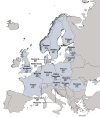Lyme borreliosis awareness and risk perception: a survey in 20 European countries
- PMID: 39844528
- PMCID: PMC11869079
- DOI: 10.1017/S0950268825000068
Lyme borreliosis awareness and risk perception: a survey in 20 European countries
Abstract
An estimated 129000 cases of Lyme borreliosis (LB) are reported annually in Europe. In 2022, we conducted a representative web-based survey of 28034 persons aged 18-65 years old in 20 European countries to describe tick and LB risk exposures and perceptions. Nearly all respondents (95.0%) were aware of ticks (range, 90.4% in the UK to 98.8% in Estonia). Among those aware of ticks, most (85.1%) were also aware of LB (range, 70.3% in Switzerland to 97.0% in Lithuania). Overall, 8.3% of respondents reported a past LB diagnosis (range, 3.0% in Romania to 13.8% in Sweden). Respondents spent a weekly median of 7 (interquartile range [IQR] 3-14) hours in green spaces at home and 9 (IQR 4-16) hours away from home during April-November. The most common tick prevention measures always or often used were checking for ticks (44.8%) and wearing protective clothing (40.2%). This large multicountry survey provided needed data that can be used to design targeted LB prevention programmes in Europe.
Keywords: Lyme borreliosis; Lyme disease; knowledge, attitudes, and practices; survey; ticks.
Conflict of interest statement
All authors are employees of Pfizer and may hold stock or stock options.
Figures


References
-
- Lindgren E and Jaenson TGT (2006) Lyme borreliosis in Europe: Influences of Climate and Climate Change, Epidemiology, Ecology and Adaptation Measures. Switzerland: World Health Organization Geneva.
-
- Vandekerckhove O, De Buck E and Van Wijngaerden E (2021) Lyme disease in Western Europe: an emerging problem? A systematic review. Acta Clinica Belgica 76(3), 244–252. - PubMed
MeSH terms
LinkOut - more resources
Full Text Sources
Medical
Miscellaneous

